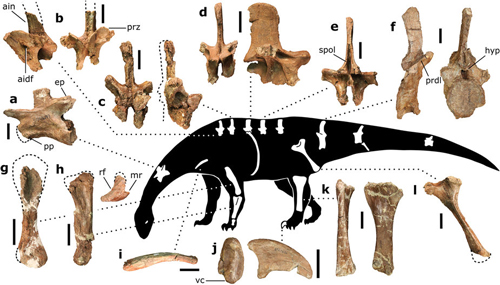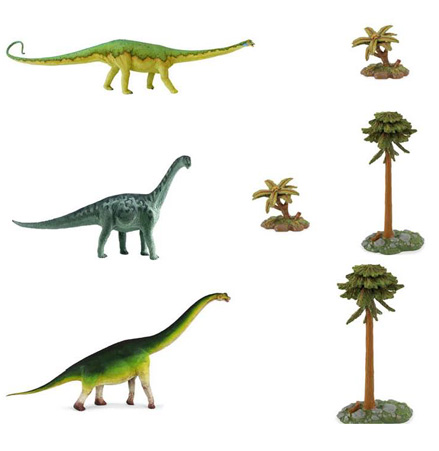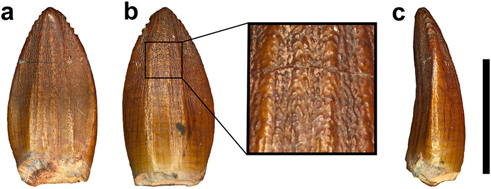Pulanesaura – A Case of “Four Legs Good Two Legs Bad”
South African Basal Sauropod Sheds Light on Niche Partitioning in Early Jurassic Herbivores
What does a quotation from George Orwell’s famous novella “Animal Farm” that satirises the Soviet system have in common with a newly described South African dinosaur? Not a lot, you might think, but the slogan “Four Legs Good, Two Legs Bad” coined by the animals in the book can be aptly applied to the fossilised remains of a newly described Early Jurassic long-necked dinosaur.
The fossils of Pulanesaura eocollum suggest that this plant-eater spent all its life as a quadruped, that is, it had become adapted to walking around on four legs and feeding on low growing plants, as opposed to the sauropodomorphs that shared its world, dinosaurs like Massospondylus, which were either semi-bipedal for full bipeds.
Basal Sauropod
This four-legged stance would have given this eight metre long, five tonne herbivore a very efficient feeding platform, perhaps, providing it with a distinct advantage over the other dinosaurs that it shared its habitat with.
A Diagram Showing Suggested Body Shape and Some of the Fossilised Bones of P. eocollum
Picture credit: Witwatersrand University
The picture above shows representative fossil bones of the new sauropod. The fossils were excavated from a small quarry measuring a little over ten square metres in size from a farm in the Spion Kop locality (Senekel District of the Free State, South Africa). The close proximity of the fossils and the depositional environment which represents a low energy deposit dominated by poorly bedded sandstones and silts, suggests this site relates to a cut-off channel.
Fossils collected indicate the presence of two sub-adult to adult sized specimens. Analysis of the almond-shaped teeth found in association with the bones along with the robust forelimbs suggest that Pulanesaura fed close to the ground, whilst its contemporaries, dinosaurs like Massospondylus and Arcusaurus (fossils of which were found at the edge of the same quarry), used their arms to help gather food from across a broad range of the forest canopy.
Head Down Browsers
The dinosaur, described by University of Witwatersrand PhD student Blair McPhee and colleagues in the journal “Scientific Reports” provides evidence of niche partitioning in Early Jurassic sauropods. Niche partitioning is defined as the process by which natural selection drives competing species into different patterns of resource use or different niches.
Niche partitioning in this way permits a number of similar animals to co-exist in an environment as each species does not directly compete with the other. In simple terms, the stocky, heavy-set Pulanesaura may have specialised in grazing upon low growing plants such as ferns and horsetails, a “head down” approach to finding its dinner as described by one member of the Everything Dinosaur team. In contrast, sauropodomorphs which could behave as facultative quadrupeds (mostly adopting a bipedal stance but able to go down on all fours if they desired), would feed on taller plants and trees, a “heads up” feeding strategy.
Niche Partitioning
This concept of niche partitioning in the Sauropoda has been applied before, notably when the extensive Late Jurassic sauropod fossil material from the Morrison Formation of the western United States is considered. In the Late Jurassic, brachiosaurids and diplodocids lived side by side, along with camarasaurids. Different dinosaur body shapes and neck lengths permitted each type of plant-eater to specialise on feeding on particular parts of the available flora.
Niche Partitioning in Late Jurassic Sauropods
Picture credit: Everything Dinosaur
Other authors of the paper include Dr Matthew Bonnan (Stockton University), Dr Jonah Choiniere (Evolutionary Studies Institute at Witwatersrand University), Dr Adam Yates (Scientist at the Museum of Central Australia) and Dr Johann Neveling (Geologist from the Council of Geoscience). The scientists conclude that Pulanesaura was an early member of the long-necked sauropod lineage of dinosaurs, distantly related to the super-sized Sauropoda that evolved later in the Jurassic and an early exponent of the “four legs good” lineage of plant-eating dinosaurs that were to dominant terrestrial habitats for much of the Jurassic.
Commenting on the significance of this dinosaur discovery, student Blair McPhee stated:
“This dinosaur showcases the unexpected diversity of locomotion and feeding strategies present in South Africa 200 million years ago. This has serious implications for how dinosaurs were carving up their ecosystems.”
Pulanesaura eocollum – A Basal Sauropod
The exact date of the strata from which the fossils come from is difficult to determine. The rocks containing the Pulanesaura material are associated with the Upper Elliot Formation, precise dating remains controversial with broad estimates of the age of these rocks ranging from 200 million years to around 180 million years old.
Dr Jonah Choiniere added:
“We used to think that only two species of sauropodomorph dinosaur were present in South Africa. Now we know that the picture was much more complicated, with lots of species present. But Pulanesaura is still special because it was doing something that all these newly discovered species were not.”
The Teeth of the Plant-Eating Dinosaur
Picture credit: University of Witwatersrand
There are two broken teeth associated with the fossil bones. They are very similar to the teeth found in most basal sauropods. The dinosaur’s name Pulanesaura eocollum is derived from the local language “Pulane” meaning rain-maker/bringer, a reference to the very wet conditions that the field team encountered when excavating the fossils.
What’s in a Name?
The species name means “dawn neck”, a direct reference to the anatomical modifications in the neck identified by the scientists which probably meant that this dinosaur did not have to move its body around too much in order to feed. Less movement equates to less energy being expended to gather food, an efficient method of feeding that was to be taken to extreme lengths by the gigantic Sauropods that evolved later.
Stockton University’s Dr Matthew Bonnan summed up the importance of this fossil discovery by explaining:
“The traditional picture of sauropod evolution is that when they came onto the scene, the other Sauropodomorphs were pushed aside. Pulanesaura turns this notion on its head. Sauropod evolution was occurring alongside and influenced by competition with their sauropodomorph brethren.”
For models and replicas of Jurassic sauropods and other prehistoric creatures: CollectA Deluxe Prehistoric Animal Figures.




